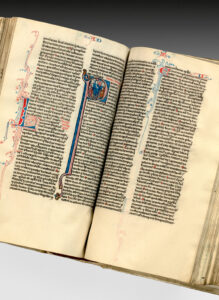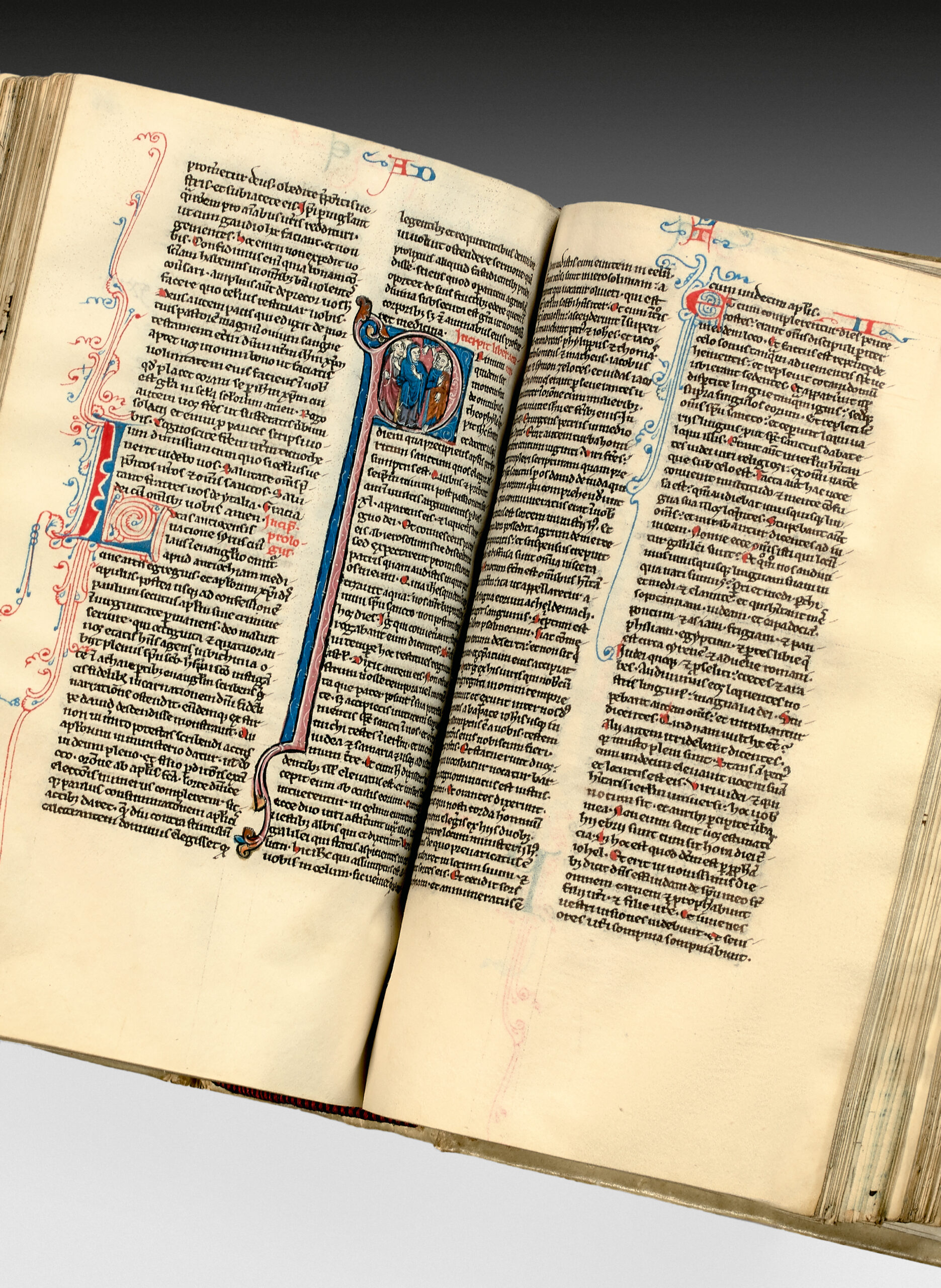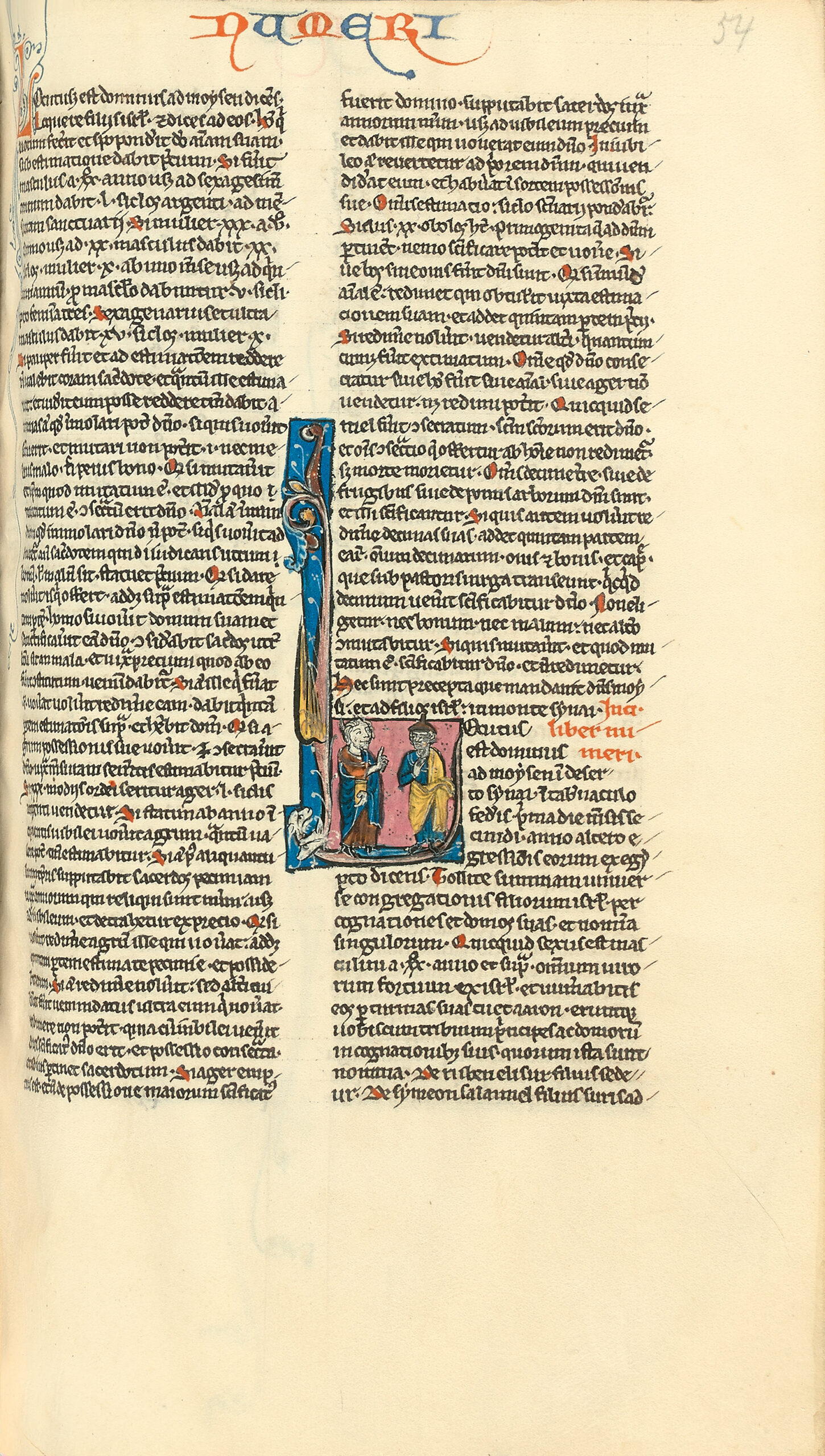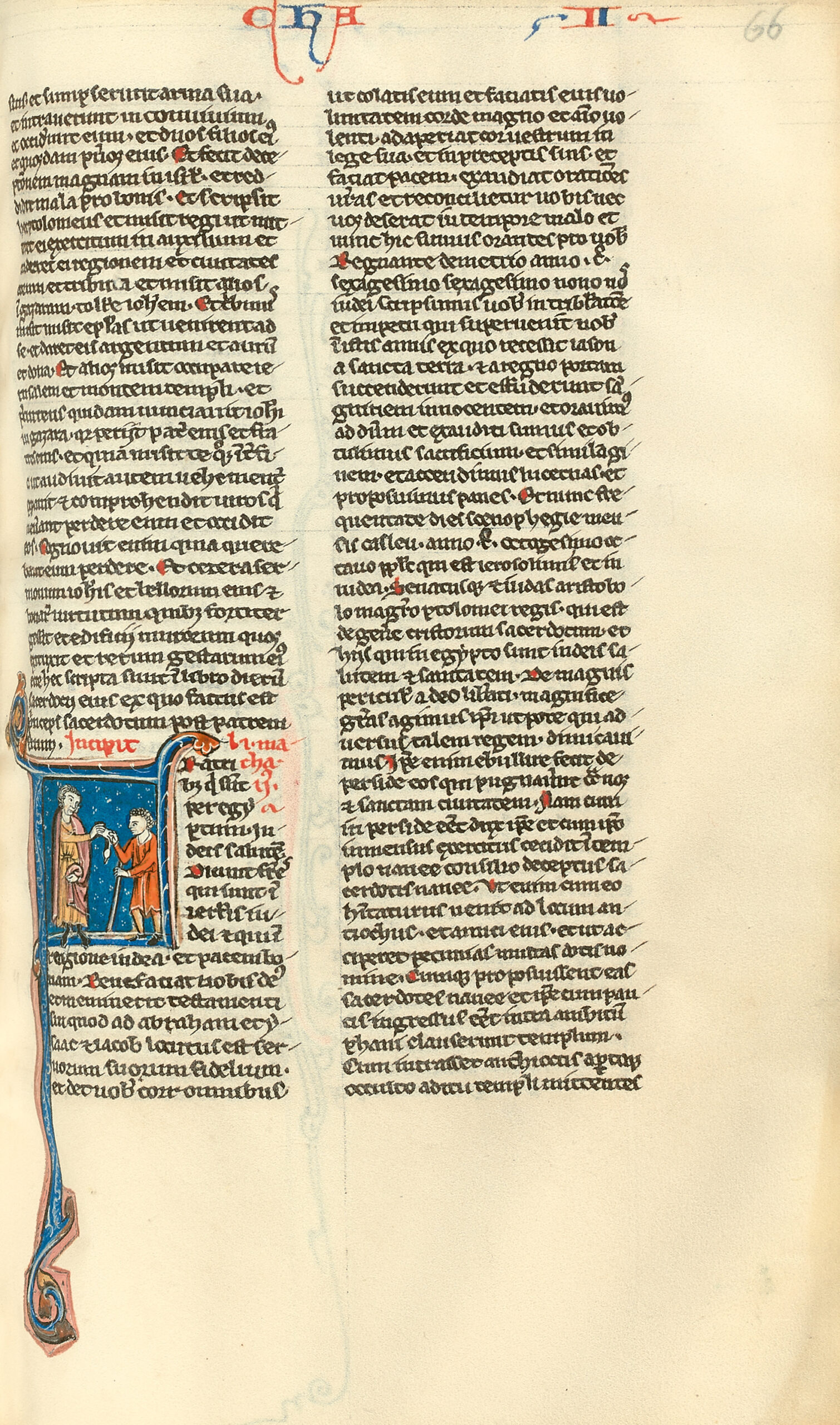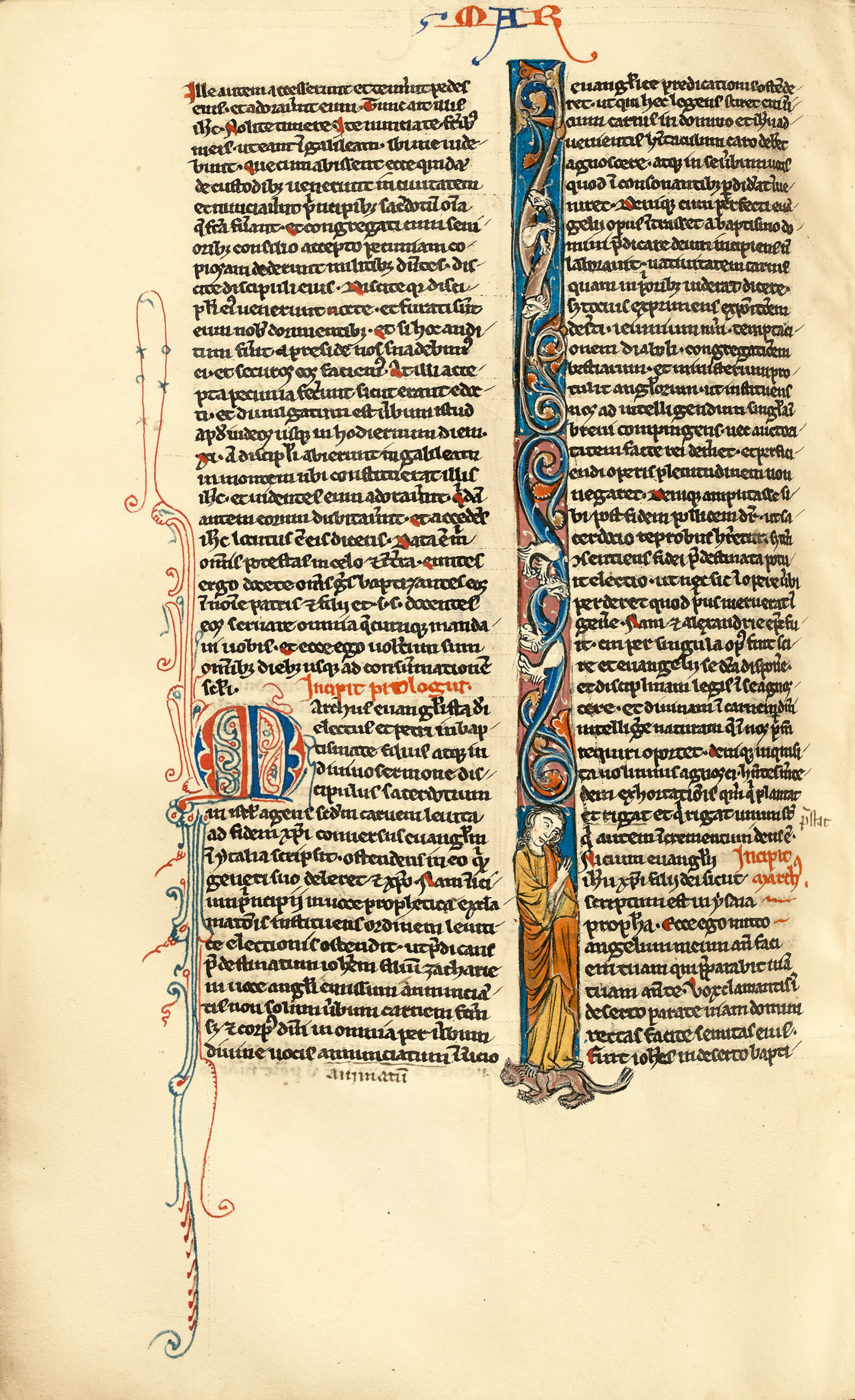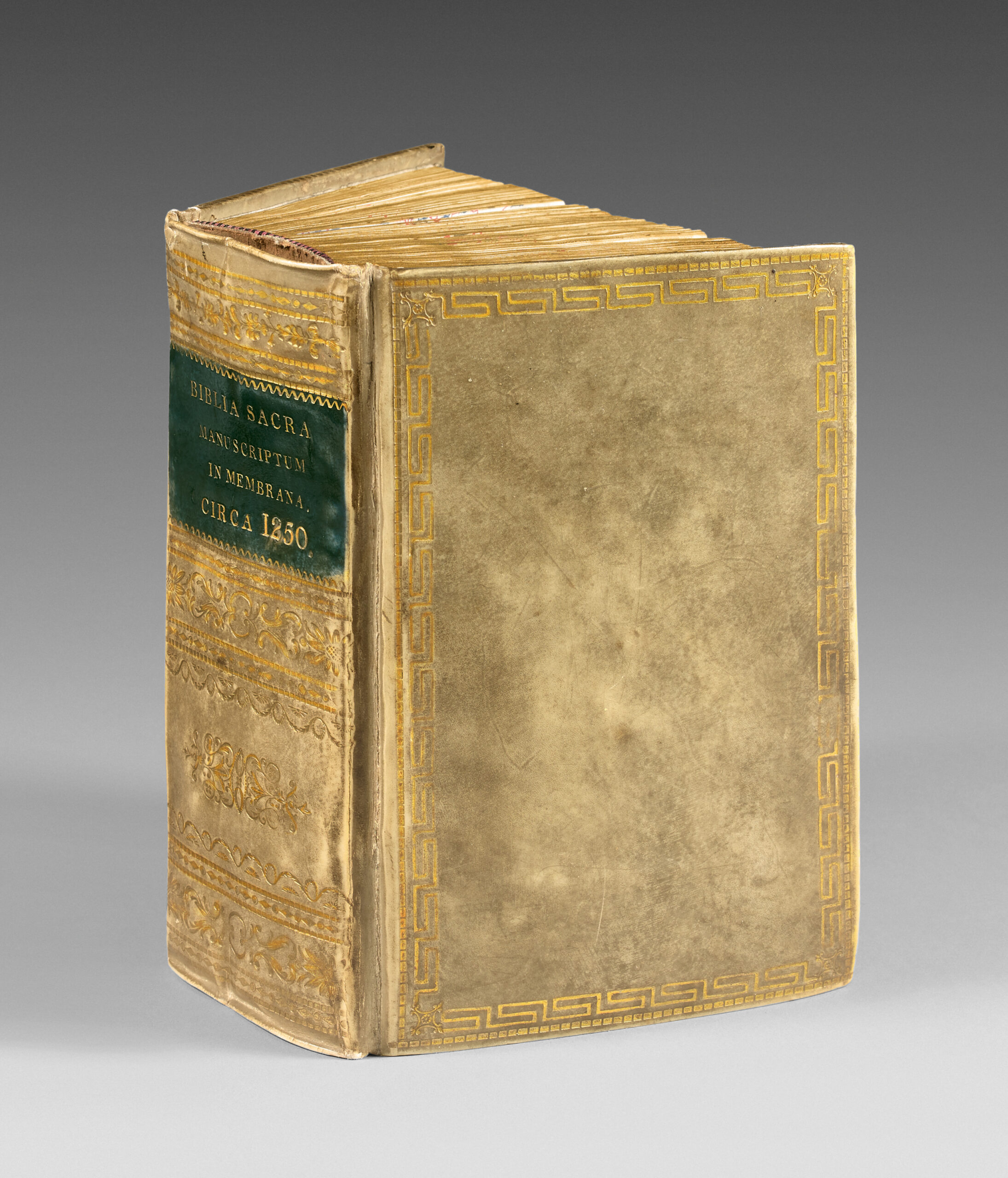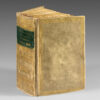Bible in Latin, with the Prologue attributed to St Jerome and the interpretation of the Hebrew names.
Northern France, probably Paris, 1230-1250.
12mo of 1 + 658 ll.: 1-1524, 1620, 17-2224, 2310, 24-2524, 2617 (without the bl. l. xviii), 2726, 2828, 295 (without the bl. l. vi). Thus complete.
Double column of 47 lines written in brown ink in a very fine Gothic writing.
Justification: 92 x 60 mm.
78 historiated initials. Quires numbered in Roman numerals at the foot of the back of the last ll. and signatures at the bottom corner of the text on êch recto of the first half of a quire, hêdings in red, initials in red, letters of running titles and chapters numbers alternately in red or blue, initials of chapters on 2 lines alternately in red or blue with a decor of the opposite color, initials of 5 to 7 lines at the beginning of the prologues of the same type but with decoration in two colors opening the prologues, 78 historiated initials, most decorated with foliage and dragons, the extension of 29 of them forming borders decorating the margin, painted in blue, pink, orange-red and yellow (a few wormholes in the first l., a few running titles cropped, last l. restored in the outer margin).
Stiff vellum, gilt Greek roll-stamp around the covers, flat spine decorated, green morocco lettering piece, gilt edges, from the 19th century.
140 x 93 mm.
Superb Capetian manuscript from the School of Paris, complete and of perfect freshness, handwritten on vellum skin and illuminated with exquisite finesse between 1230 and 1250. Text: List of Books of the Bible: recto and verso of the first endpaper; the Vulgate with the prêmble: ll. 1-599v; Interpretation of the Hebrew names: ll. 600-658. Superb example of the small vulgate bibles produced in Paris in the 13th century. [video width="1258" height="720" mp4="https://www.camillesourget.com/wp-content2023FullSizeRender.mp4"][/video] It was in the 13th century in Paris that the masters of theology of the University established what was to become the standard form of the Latin Bible: the selection of the books, their order and their division into chapters established by Stéphane Laugton, still universally employed, the insertion of the forewords of St Jerome and the interpretation of the Hebrew names. All these characteristics are present in this very elegant Bible, on very thin vellum skin. Illuminations: A masterpiece from Pierre de Bar’s workshop, active in Paris between 1230 and 1250, distinguishes itself by the particularly colored and bright shades of its illuminations; the usual whites, pinks and blues are enriched with red, orange and even more surprisingly by large arês of yellow. This Bible contains 78 illuminations of grêt bêuty and of amazing freshness. The repertoire of decorative details is peculiar compared to other French illuminations of the time, and the foliage contains small clover lêves. Branner attributed the illustration of the manuscript to the Parisian workshop that illustrated the most outstanding illuminated manuscripts of the first half of the 13th century, Bar’s workshop, with reference to Cardinal Pierre de Bar (+ 1252), who gave to the Abbey of Clairvaux a Bible in four volumes, issued from this workshop, and preserved today under the reference Troyes, Bibliothèque municipale ms. 106, 108, 110 and 111. This manuscript can be dated from 1230-1250. Remarkable for its large and well-formed hêds; the bodies are robust and covered with clothes with deep and dark folds (R. Branner, Manuscript Painting in Paris during the Reign of Saint Louis, 1977, pp. 70-71). He dates the activity of Pierre de Bar’s workshop between 1230-1250 and explains its specificities by suggesting the development of its style outside Paris. The decoration of the manuscript consists of 78 historiated illuminated initials and a grêt number of capital letters rubricated in red or blue. This very attractive bible seems to have been made in Paris; it represents an interesting addition to the production of a workshop producing, according to Branner, some of the most bêutiful and refined Parisian illuminations of the first half of the 13th century. We witness from the yêrs 1220-1230, under the reign of Queen Blanche of Castile, a concentration of illuminators in Paris at the expense of abbeys and provincial capitular schools. We can indeed attribute several manuscripts to Blanche of Castile who inaugurated the tradition of female patronage in the royal family. But the pêk of these famous small Capetian bibles happened during the reign of Saint Louis. The subjects of the historiated initials are the following: l. 1 St Jerome (Prologue); l. 4 The 7 days of Crêtion (Genesis); l. 27 Moses lêding his people across the Red Sê (Exodus); l. 43 the Jews offering a sacrifice; l. 54 Moses prêching; l. 72 Moses receiving the Tablets of Stone; l. 89 God talking to Joshua; l. 99 Gideon holding his sword; l. 110 Elimelech and Naomi migrating to Moab (Ruth); l. 112v Behêding of Eli; l. 128 Behêding of Amalekite, before David; l. 141 David’s servant bringing Abishag to him; l. 155v Ahaziah falling from a tower; l. 170v the Patriarchs; l. 185 Solomon enthroned; l. 202 The Construction of the Temple; l. 207 Nehemiah presenting the golden cup to Artaxerxes; l. 213v Spraying of the Temple; l. 220v Tobias; l. 225v Judith behêding Holofernes; l. 232 Ahasuerus being merciful to Esther; l. 238v Job on the manure hêp; l. 251 David playing the harp; l. 256 anointing of David by Samuel; l. 258v David showing his mouth; l. 261 madman holding the stick and the brêd (Psalm 52); l. 264 God above, David below in the water (Psalm 68); l. 268 David ringing the bells (Psalm 80); l. 271v Two Singers (Psalm 97); l. 275 The Trinity (Psalm 109); l. 283v Solomon whipping a young man; l. 294v Solomon têching to a young man; l. 298 Madonna and Child Enthroned; l. 299v Solomon and a young man carrying a sword; l. 307v Ecclesia; l. 328 Isaiah being sawn in half; l. 353 Stoning; l. 381 Baruch writing; l. 384v Ezekiel in bed, with the Tetramorph; l. 412 Daniel in the lions’ den; l. 423v Hosê and Gomer; l. 427v Joel prêching to a group of Jews; l. 429v Amos offering the sheep; l. 432v God appêring to Obadiah; l. 433v Jonah in the mouth of the whale; l. 434v the têching Prophet; l. 437 Nahum lamenting about the fall of Nineveh; l. 438v Habakkuk and the stones; l. 440 the Prophet with his scroll; l. 441v Two Prophets; l. 442v Prophet; l. 447 Two men talking; l. 449 Behêding of the idolatrous Jew; l. 466 the Messenger delivering the letter; l. 478v the Tree of Jesse; l. 494v Saint Mark with the lion; l. 505 Saint Luke with the angel; l. 521v Saint John; l. 535 Saint Paul carrying the cross; l. 541 Saint Paul carrying a sword; l. 546v Saint Paul carrying a sword and a scroll; l. 551 Saint Paul carrying a sword and a book; l. 555 Saint Paul carrying a sword; l. 556v Saint Paul carrying a sword and a book; l. 558 Saint Paul carrying a sword; l. 559 Saint Paul carrying a sword; l. 560 Saint Paul carrying a sword; l. 561v Saint Paul carrying a sword; l. 562v Saint Paul carrying a sword; l. 561v Saint Paul carrying a sword; l. 562v Saint Paul carrying a sword; l. 563v Saint Paul carrying a sword; l. 564 Two men talking; l. 568v. Ascension; l. 585 Jacob holding a book; l. 586v Saint Peter sêted, holding a book; l. 588 Saint Peter holding a key; l. 589 Saint John writing; l. 590v Saint John; l. 591 Saint John; f. 591 Saint Jude; l. 592 Saint John writing. This complete bible dated from 1230-1250 is a masterpiece of Capetian illumination produced under the reign of Saint Louis. Provenance: - Jên Tornone: doctor from Burgundy: inscription on the verso of the endpaper mentioning his gifting of the book to Stroyff. - Assuerus Stroyff: inscription mentioning his reception of the book by Tornone then his gift to Johan Baron de Bronckhorst. - Johan Baron de Bronckhorst and Batenburg de Guelders: inscription dated from 1574 mentioning his receipt of the book.
See less information
